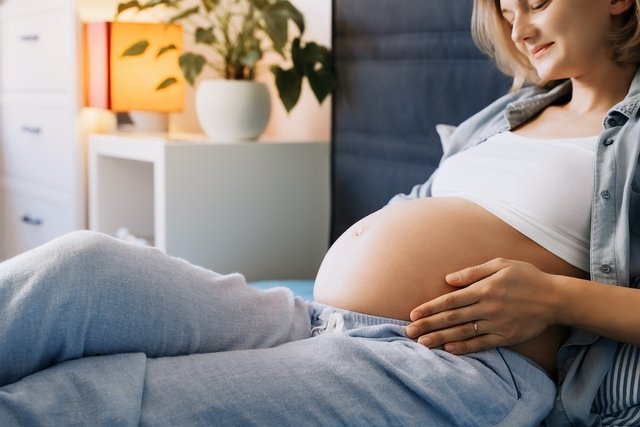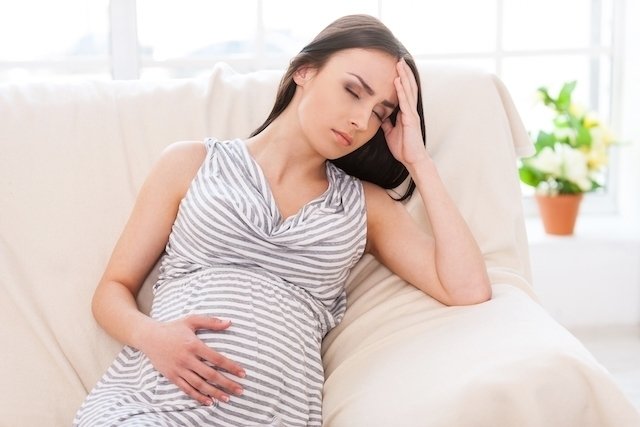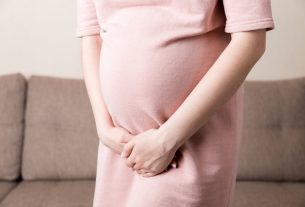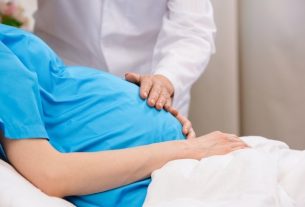Colic during pregnancy is normal, especially at the beginning of pregnancy, due to the implantation of the embryo and the adaptation of the woman’s body to the baby’s growth, and also at the end of pregnancy, around 37 weeks of gestation, giving signs of the beginning of labor. of birth.
However, there are other situations that can cause severe cramps, such as ectopic pregnancy, ovular or placental abruption, or miscarriage, and which may be accompanied by other symptoms such as vaginal bleeding, discharge or fever.
Read too: Colic: what it is, types, causes (and what to do)
It is important to contact the obstetrician or look for the nearest hospital when symptoms of colic appear that are frequent, painful and do not stop even when resting, so that a doctor can evaluate them and initiate the most appropriate treatment, which depends on the cause. of colic.

Colic in the 1st trimester of pregnancy
The main causes of colic in the 1st trimester of pregnancy, which corresponds to weeks 1 to 13 of pregnancy, are:
1. Embryo implantation
Colic at the beginning of pregnancy is normal and can be caused by the implantation of the embryo in the uterus, which occurs around 6 to 12 days after fertilization, and a small pinkish bleed may also occur, and generally lasts around 2 days.
In this initial phase of pregnancy, the fertilized egg implants itself in the uterus, starting the division of the embryo’s cells and stimulating the woman’s body to produce the hormone beta-HCG to create conditions for the baby to develop inside the uterus, and symptoms may also appear. such as morning sickness or breast tenderness, which can be confused with PMS symptoms. Learn how to differentiate PMS symptoms and pregnancy.
How to relieve: When experiencing colic at the beginning of pregnancy, it is recommended to rest and relax, which can help alleviate the discomfort of colic related to embryo implantation, which normally improves within 2 days.
Don’t ignore the signs your body is giving you!
2. Tubal pregnancy
Tubal pregnancy, also called ectopic pregnancy, occurs when the embryo develops outside the uterus, being more common in the fallopian tubes, also called uterine tubes, which can cause intense cramping on just one side of the belly and which worsens with movement. .
Colic caused by tubal pregnancy is usually accompanied by other symptoms such as vaginal bleeding, pain during intimate contact, dizziness, nausea, vomiting or fainting.
How to relieve: In the case of the presence of symptoms of tubal pregnancy, you should seek the nearest emergency room immediately so that tests can be carried out, confirm the diagnosis and begin the most appropriate treatment, which is generally carried out through surgery to remove the embryo. Find out how ectopic pregnancy is treated.
3. Urinary tract infection
Urinary tract infections are very common during pregnancy, and may not cause symptoms at an early stage, but can often cause colic in the pelvic region, burning and difficulty urinating, an urgent urge to urinate even though there is little urine, fever and nausea.
Urinary tract infections are more common at the beginning of pregnancy, but they can also appear at any stage of pregnancy, due to the changes that occur in the woman’s body during pregnancy, which can favor the development of bacteria in the urinary tract.
How to relieve: You should consult your obstetrician for a urine test to confirm the urinary infection and start treatment with antibiotics, such as cephalexin, for example. Furthermore, it is recommended to rest, increase fluid intake and not hold urine. See more about the treatment of urinary tract infections during pregnancy.
4. Ovular detachment
Ovular detachment is a condition that occurs due to an accumulation of blood between the placenta and the uterus caused by the detachment of the gestational sac from the wall of the uterus, and which can lead to cramping, bleeding or abdominal pain.
Ovular detachment, scientifically called subchorionic or retrochorionic hematoma, is a situation that can happen during the first trimester of pregnancy and, in milder cases, can disappear on its own by the end of the second trimester of pregnancy, as it is absorbed by the woman’s body. woman.
However, when the hematoma is large, there is a greater risk of premature birth, miscarriage, or placental abruption.
How to relieve: It is important to look for the nearest hospital immediately so that the ultrasound can be performed and the need to start the most appropriate treatment can be assessed, which can be done with partial or absolute rest, avoiding intimate contact, and in some cases, hormonal treatment with progesterone, indicated by the doctor. Furthermore, it is also important to drink at least 2 liters of water per day. See more details on the treatment of ovular detachment.
5. Miscarriage
A miscarriage can cause intense cramping in the lower back, pain in the lower back and/or pelvis, accompanied by brownish bleeding, heavy bleeding or the release of blood or tissue clots, which worsen over the days. Furthermore, colic may be accompanied by other symptoms such as intense or constant headache, or general malaise.
Spontaneous miscarriage is more common to occur in the first trimester of pregnancy, but it can also occur in the second trimester of pregnancy, before 20 weeks, due to various situations, such as excessive physical activity, use of medications, consumption of certain teas, infections or trauma. Learn about other causes of miscarriage.
How to relieve: You should go to the emergency room immediately if symptoms of a miscarriage appear, to carry out tests such as ultrasound and assessment of the fetal heartbeat, and thus obtain a diagnosis. In the case of confirmed miscarriage, treatment must be carried out by the doctor through curettage or surgery to remove the baby. Find out how curettage is done.
Colic in the 2nd trimester of pregnancy
The main causes of colic in the 2nd trimester of pregnancy, which corresponds to weeks 14 to 27 of pregnancy, are:
1. Pelvic pain
Pelvic pain, also called round ligament pain, can lead to cramps on one or both sides of the lower abdomen, which last a few seconds or minutes and usually appear when the woman changes position too much. quickly, when sitting or lying down, or when coughing or sneezing.
This condition is caused by the stretching and narrowing of the ligaments that support the belly, due to the growth of the uterus, and is a normal condition during pregnancy.
How to relieve: Maintaining good posture, avoiding prolonged periods of standing or sitting and changing positions when lying down can help alleviate discomfort. Furthermore, doing light stretches and gentle movements, practicing yoga or Pilates, as long as approved by your doctor, help to strengthen your muscles to withstand the changes in your body during pregnancy. However, if the pain does not improve, or if you develop a fever, you should contact your doctor immediately.
2. Placental abruption
Placental abruption occurs when the placenta is separated from the wall of the uterus as a result of inflammation or changes in blood circulation in the placenta, causing intense cramps, low back pain and vaginal bleeding, being more common after 20 weeks of pregnancy.
Placental abruption can be caused by intense physical exertion and high blood pressure or pre-eclampsia.
How to relieve: Placental abruption is a serious situation that requires immediate intervention, as it can put the health of the mother and baby at risk. Therefore, you should seek emergency help as soon as possible so that treatment can begin, in some cases requiring hospitalization, use of oxygen and control of blood pressure and heart rate. Learn more about placental abruption treatment.
3. Training contractions
Training contractions, also called Braxton-Hicks contractions, can appear around the 20th week of pregnancy, causing cramps that are mild and considered normal, as the muscles of the uterus can contract and relax regularly, causing the belly to tighten. become harder at certain times of the day, preparing the uterus and pelvic tissues for future childbirth.
How to relieve: moving your body or doing physical exercises recommended by your doctor helps alleviate the discomfort of contractions. However, if the contraction is strong, very frequent or accompanied by other symptoms such as back pain, vaginal bleeding or liquid discharge, you should seek medical help immediately.
Colic in the 3rd trimester of pregnancy
The main causes of colic in the 3rd trimester of pregnancy, which corresponds to weeks 28 to 41 of pregnancy, are:
1. Constipation
Constipation is more common in the third trimester of pregnancy, and occurs due to the pressure of the uterus on the intestine and decreased bowel movements, causing colic, pain on the left side, excess intestinal gas, in addition to the belly being more hard during this period. site of pain.
How to relieve: One should keep the body hydrated by drinking at least 8 glasses of water a day and eat more fiber in the form of whole grains, fresh fruits and vegetables. Practicing physical exercises regularly recommended by your doctor can also help improve intestinal transit and alleviate this discomfort. However, it is recommended to consult your obstetrician if the pain does not improve on the same day, if you do not have a bowel movement for 2 days in a row or if other symptoms such as fever or increased pain appear.
2. Pre-eclampsia
Pre-eclampsia is the sudden increase in blood pressure during pregnancy, usually in the second half of pregnancy, being more common in the third trimester, causing symptoms such as cramping in the upper right part of the abdomen, nausea, headache, swelling of the hands, legs and face, as well as blurred vision.
Pre-eclampsia is a serious complication of pregnancy that is difficult to treat and can pose a risk to both the woman and her baby.
How to relieve: It is recommended to consult an obstetrician as soon as possible to assess blood pressure and begin treatment with hospitalization, to ensure the safety of mother and baby. Find out how pre-eclampsia is treated.
3. Premature labor
Cramps that appear after 37 weeks of pregnancy, which are progressive in intensity and become more constant over time, and do not improve when changing position, may be indicative of premature labor.
Furthermore, other symptoms may be accompanied by cramps, such as a feeling of pressure in the pelvic region, vaginal discharge or light bleeding. Learn how to identify contractions during pregnancy.
How to relieve: You must inform your obstetrician immediately when contractions begin and go to the maternity ward or hospital.
When to go to the doctor
It is important that women consult their obstetrician or go to the nearest emergency room immediately when colic is persistent or accompanied by symptoms such as:
- Vaginal bleeding;
- Fever;
- Chills;
- Nausea or vomiting;
- Pain or burning when urinating;
- Urine with blood;
- Headache;
- Swelling in the hands, feet or face.
The presence of these symptoms may indicate a serious complication, which requires immediate care and treatment, which varies according to the doctor’s diagnosis.

Sign up for our newsletter and stay up to date with exclusive news
that can transform your routine!
Warning: Undefined array key "title" in /home/storelat/public_html/wp-content/plugins/link-whisper-premium/templates/frontend/related-posts.php on line 12
Warning: Undefined array key "title_tag" in /home/storelat/public_html/wp-content/plugins/link-whisper-premium/templates/frontend/related-posts.php on line 13




